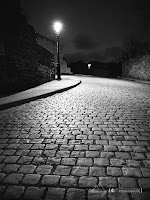 |
| Pulteneytown Harbor By W. J. Renney, 1886 |
Many
Highlanders, forced out of their homes in droves, emigrated to America, but
there were also many who moved toward the east coast of Scotland where they
could begin new lives as fishermen and boat builders. Though marine industries were
well-established in the town of Wick, it was too small to accommodate the
massive numbers displaced by the Clearances.
Therefore, Sir William Pulteney, governor of the British Fisheries
Society, commissioned Thomas Telford, Britain’s leading civil engineer of the
day, to design and establish a fishing town and harbor at the estuary of the
Wick River, a place which came to be called Pulteneytown (see image below left).

 |
| Wick Harbor, 1860s |
 |
| 26 Bank Row (second black door, left) |
Walter’s business was greatly affected
by Scotland’s competition with the Dutch, who were, early on, the leaders in
herring fishery. Copying the successful Dutch, the Scots built boats called
“herring busses,” which were outfitted with sails to carry the Dutch far into
the North Sea (see above). But Scotland had a
geographical advantage in that every summer the herring would migrate into the
Orkney area. Realizing they were better
placed than their Dutch rivals to exploit this situation, the Scots decided they could operate more quickly and
efficiently with smaller open boats, a change which kept Walter and sons quite
busy as they responded to the growing demand for open boats (see below). Soon, the Scots
moved ahead of the Dutch in the herring fishery business.
 |
| Herring Buss, Dutch Style |
I n addition to the work of boat building,
the Green family were engaged in other related trades. For example, two of Walter’s daughters, Rose
and Margaret (but not my direct ancestor, Helen), were employed as net weavers in Wick. Net weaving was a centuries-old occupation in
Caithness and was largely done by females.
Near the end of the 18th century, as the Age of
Industrialization was underway, looms were invented which would relieve the
weavers of some of their tedium. By the
late 19th century, more than 2000 people, mostly women, were
employed at nearly 600 looms in Scotland.
Surprisingly, Wick, “the metropolis of the herring fishery,”[ii] was
one of the last places to industrialize, so Rose and Margaret kept themselves
employed on the old looms for longer than most, which could be viewed
negatively by those who like to keep up with the times but perhaps more
positively by those who enjoyed the peaceful hand work at the water’s edge (see photo above).
 |
| Open Herring Boat Wick Harbor |
 |
| Fish Net Hanging on a Stick |
By 1851, when Walter was 65, he had cut
back a little from building boats, leaving that in the hands of his able
sons, and taken up another Wick-based trade, that of fish curer, which probably
required less physical strength. Fish
curers received the herring from the boats, gutted them, and packed them in
barrels. The best would receive the
stamp of the crown on the lid and would bring high prices in the European
market.
 |
| Fish-Curing Building in Pulteneytown |
 |
| Bank Row |
[i] “Old Pulteney
Whiskey.”
[ii] “Industries of
Scotland: Manufacture of Fishing Nets.”
Sources
Coull, J.
R. “Herring Fishing in Scotland.” HistoryShelf.org.
Learning in Scotland Project. n.d.
Web. 13 Apr 2013. <http://sites.scran.ac.uk/secf_final/silver/coull.php>
_______. “Silver
Darlings: The History of Herring Fishing on the East Coast of Scotland.” HistoryShelf.org. n. d. Web. 14 Apr. 2013. <http://www.historyshelf.org/secf/silver/coull.php>
“Industries of
Scotland: Manufacture of Fishing Nets.” Electric
Scotland. n.d. Web. 14 Apr. 2013. http://www.electricscotland.com/history/industrial/industry13a.htm
“Old Pulteney
Whiskey.” Whiskey.com. n.d. Web. 14 Apr. 2013. <http://www.whisky.com/brands/pulteney_brand.html>
Images
Nineteenth-Century
Fish-Curing Building in Pulteneytown. http://rls.org.uk/database/record.php?usi=000-000-505-017-C&searchdb=scran
Bank Row photograph by Gordon Mackay.
Fish
Net Hanging on a Stick.
Herring
Buss.
Open Herring
Boat in Wick.
Ordnance Survey
of Pulteneytown. http://www.scotlandsplaces.gov.uk/search_item/index.php?service=NLS&id=7830&view=full
Pulteneytown
Harbour. Painted by W. J. Renney. 1886.
http://www.historyshelf.org/secf/silver/02.php
Wick Harbour,
1860s. Alan Calder Writing.



